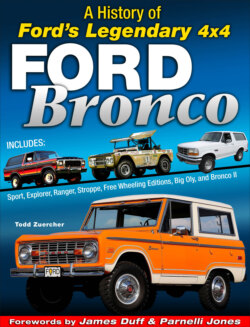Читать книгу Ford Bronco: A History of Ford's Legendary 4x4 - Todd Zuercher - Страница 23
На сайте Литреса книга снята с продажи.
Transfer Case
ОглавлениеIn choosing the Dana 20 transfer case for the Bronco, Ford selected one of the best transfer cases ever used in 4WD vehicles. This transfer case, which featured a cast-iron housing and used steel gears (not chains), enjoyed a sterling reputation for longevity and strength; Jeep specified it for its J4000 1-ton trucks.
Ford learned from its preproduction surveys that customers wanted quieter drivetrains on their 4WDs. The Spicer 18 transfer case, which had been used in Jeeps since their introduction and in Scouts until 1965, was a so-called “offset design” (the input and output shafts were not colinear), requiring an intermediate shaft and gears as part of the power transmission from the input shaft to the output shaft. The extra gears generated noise, particularly at highway speeds, which consumers found tiresome.
The Dana 20 was a “straight through” or “silent drive” design, highly touted at the Bronco’s introduction. Because the input and output shafts were colinear, there were no gears moving in the transfer case when operated in two-wheel drive (2WD), resulting in much less gear train noise. And although the Scout 800 had started using the Dana 20 in 1965, the International Harvester unit had a low range ratio of 2.03:1, compared to the 2.46:1 low ratio of the Bronco Dana 20, which was much more desirable for those enthusiasts looking for the lowest possible crawl ratio.
The mid-1960s was also a time when manufacturers were moving from the twin-stick transfer case shifters to single sticks to make shifting into 4WD less confusing and intimidating for first-time 4WD owners. Jeep had made the jump to a single-stick transfer case in its CJ-5 with the introduction of the 225-ci V-6 engine in 1965, and Ford followed suit with the Bronco (its F-Series 4x4 pickups always had them).
The single transfer-case shifter found on the 1966 Broncos is a textbook example of engineering revisions during production as customer feedback revealed weaknesses.
The initial shifter design was a single lever topped with a traditional shifter knob denoting the shift pattern, similar in design to the shifters used in other vehicles but longer in length, presumably to ease shifting effort. Several testers in early magazine reviews noted that the resulting shifter position was very close to the column-mounted transmission shifter when it was in third gear. Four Wheeler, in particular, noted that the shifter knob tips were less than an inch apart, and they feared that a driver may inadvertently shift into 4WD high.
International Harvester, in a period document that compared the Scout to the Bronco, noted that there were reports of the Bronco shifter breaking off at the transfer case due to the increased leverage of the long lever. The obvious agenda of a competitor’s document notwithstanding, broken shift levers were reported by other 1966 owners.
Apparently, Ford listened to these complaints and later production models used a shorter version of the same shifter. Late in the model year, coinciding with the introduction of the V-8, Ford made a switch again to a shifter topped by a chrome T-handle. The handle housed a push-button assembly that actuated a gated plate at the base of the assembly to lock the shifter into the specific gearing options in the transfer case.
These first T-handle shifters had boots similar to, but larger than, the first-generation 1966 shifters. The driver still had to rely on the shift-pattern decals on the dash to determine exactly what gear the transfer case was in, and it likely took some time and finesse for owners to figure this out. The base of the shifter was modified as well with a stronger configuration that worked well for the next six model years.
Ford used double Cardan U-joints at the transfer end of the front and rear driveshafts in the Bronco. This allowed the transfer case to be mounted higher inside the frame for additional ground clearance.
